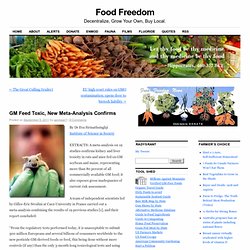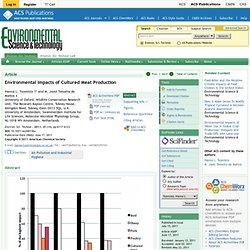

GM Feed Toxic, New Meta-Analysis Confirms. By Dr Eva SirinathsinghjiInstitute of Science in Society EXTRACTS: A meta-analysis on 19 studies confirms kidney and liver toxicity in rats and mice fed on GM soybean and maize, representing more than 80 percent of all commercially available GM food; it also exposes gross inadequacies of current risk assessment.

A team of independent scientists led by Gilles-Eric Séralini at Caen University in France carried out a meta-analysis combining the results of 19 previous studies [1], and their report concluded: “From the regulatory tests performed today, it is unacceptable to submit 500 million Europeans and several billions of consumers worldwide to the new pesticide GM-derived foods or feed, this being done without more controls (if any) than the only 3-month-long toxicological tests and using only one mammalian species, especially since there is growing evidence of concern.”
Multiple organ abnormalities revealed on re-analysis. The decline of agriculture? - Features. Wendy Johnston with Oakwyn Farms in Athens, West Virginia, is deeply concerned about how shifting weather patterns are impacting farmers' ability to feed the global population.

"This year we're off to a slow start," Johnston, who farms 40 hectares, told Al Jazeera. "Last year in April we were able to plant, but this year we even had rain, cold and snow a few days in April. The weather has become very unpredictable, and that's the real problem. " Climate change is making farming more difficult for her, and she wonders how much worse things will become. On March 31, The Food and Agriculture Organisation (FAO) warned of "potentially catastrophic" impacts on food production from slow-onset climate changes that are expected to increasingly hit the developing world.
The report filed with the United Nations Framework Convention on Climate Change, warned that food production systems and the ecosystems they depend on are highly sensitive to climate variability and change. Soil in peril. Environmental Impacts of Cultured Meat Production - Environmental Science & Technology. University of Oxford, Wildlife Conservation Research Unit, The Recanati-Kaplan Centre, Tubney House, Abingdon Road, Tubney, Oxon OX13 5QL, U.K.

University of Amsterdam, Swammerdam Institute for Life Sciences, Molecular Microbial Physiology Group, NL-1018 WV Amsterdam, Netherlands Environ. Sci. Technol., 2011, 45 (14), pp 6117–6123 DOI: 10.1021/es200130u Publication Date (Web): June 17, 2011 Copyright © 2011 American Chemical Society Section: Abstract Cultured meat (i.e., meat produced in vitro using tissue engineering techniques) is being developed as a potentially healthier and more efficient alternative to conventional meat.
Citing Articles. Johann Hari: Cheap meat, MRSA and deadly greed - Johann Hari, Commentators. As the scientists I've interviewed explain it, antibiotics do something simple.

They kill, slow down or stall the growth of bacteria. They were one of the great advances of the 20th century, and they have saved millions of us. But they inherently contain a problem – one that was known about from very early on. They start an arms race. Use an antibiotic against bacteria, and it kills most of it – but it can also prompt the bacteria to evolve a tougher, stronger, meaner strain that can fight back. So the more we use antibiotics, the more we lose them. In the United States, Latin America, and Asia, animals being farmed for meat and milk are being automatically given antibiotics in their food all day – irrespective of whether they are healthy or sick. You can see how this process makes bacteria stronger and tougher – and at work on humans – in a startling study by Professor Barry Levy in the New England Journal of Medicine.
7 Disruptive Foods Changing the Way We Eat. Everyone is different, but we all eat.

Maybe that’s why food is such a popular topic these days, online and off: Debates over organic produce, genetically modified foods, cage-free chickens, rising food prices, fast food production, how to feed the world’s exploding population and where to get the best banh mi rage wherever we turn. Wired.com’s Epicenter blog, which covers disruptive technology that changes your world, turns its focus to mealtime today with a look at some of the top disruptive foods set to change the way we eat, from the whimsical to the nutritional and beyond. What did we miss? Add your suggestions below and we’ll gather them all into a poll along with the following examples: Nuclear nanobots would power human cells -- such as these stained neural cells -- in one vision of the future.
Pages: 1 2345678View All. Food as 5th-gen warfare vector. There’s a lot of things on which Thomas Barnett and I would disagree, but there’s no getting around the way he can see further ahead than most foreign policy wonks.

Forget oil, and start worrying about food supply: Everybody thinks that the future is going to see fights over energy, when it’s far more likely to be primarily over food. Think about it: The 19th century is the century of chemistry and that gets us chemical weapons in World War I. The 20th century is the century of physics and that gets us nuclear weapons in World War II. But the 21st century? Not so sure about his “century of [x]” reasoning, and I’d argue that we’ve seen the “wars over energy” being played out in the Middle east over the last few decades (with, sadly, more to come, though I think we could be in the final act of that particular movie), but by highlighting food supply as an infrastructure that could (and will) be leaned on to highly disruptive effect, I think he’s pretty much spot on.